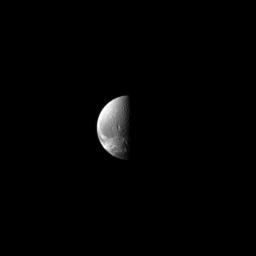
|
Down Dione Way
- Click the image above for a larger view
- Full-Res JPEG (549 x 549) (5.6 kB)
- Full-Res TIFF (549 x 549) (302.0 kB)
Caption:
Looking down toward the north pole of the moon Dione, the Cassini spacecraft sights wispy features.
These linea cover the trailing hemisphere of the moon. Cassini high resolution images revealed these bright features to be geologically young fractures exposing the icy surface of the moon. (See PIA07638 ).
Lit terrain seen here is mostly on the Saturn-facing side of Dione (1,123 kilometers, or 698 miles across), but the wispy area is on the moon's trailing hemisphere. The north pole lies on the terminator about a quarter of the way inward from the top of the image. The image was taken in visible light with the Cassini spacecraft narrow-angle camera on May 2, 2009. The view was acquired at a distance of approximately 1.4 million kilometers (870,000 miles) from Dione and at a Sun-Dione-spacecraft, or phase, angle of 88 degrees. Image scale is 8 kilometers (5 miles) per pixel.
Background Info:
The Cassini-Huygens mission is a cooperative project of NASA, the European Space Agency and the Italian Space Agency. The Jet Propulsion Laboratory, a division of the California Institute of Technology in Pasadena, manages the mission for NASA's Science Mission Directorate, Washington, D.C. The Cassini orbiter and its two onboard cameras were designed, developed and assembled at JPL. The imaging operations center is based at the Space Science Institute in Boulder, Colo.
For more information about the Cassini-Huygens mission visit http://saturn.jpl.nasa.gov/ . The Cassini imaging team homepage is at http://ciclops.org .
Cataloging Keywords:
| Name | Value | Additional Values |
|---|---|---|
| Target | Dione | Saturn |
| System | Saturn | |
| Target Type | Satellite | Planet |
| Mission | Cassini-Huygens | |
| Instrument Host | Cassini Orbiter | |
| Host Type | Orbiter | |
| Instrument | Imaging Science Subsystem (ISS) | |
| Detector | Narrow Angle Camera | |
| Extra Keywords | Grayscale, Visual | |
| Acquisition Date | ||
| Release Date | 2009-06-09 | |
| Date in Caption | 2009-05-02 | |
| Image Credit | NASA/JPL/Space Science Institute | |
| Source | photojournal.jpl.nasa.gov/catalog/PIA11510 | |
| Identifier | PIA11510 | |
